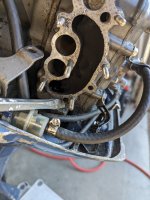removed the inlet manifold and water hoses again....YES, or you'll hear air coming out those two small holes at the back of the housing
1) air flows easily from pump y junction to thermostat housing. tells me water can get through the block and to the thermostat. thermostat is missing but the housing is oddly dry even though the passage seems clear
2) the water jacket around the heads seems clear as air can pass from small hole to small hole easily
3) I blocked the lower small hole as you suggested. when I sent air through other hole (thermostat output I believe) NO AIR CAME OUT of the holes at the back of the housing or the exhaust. The main cooling flow around the heads doesn't seem to be happening.
4) I did feels some air coming out.of the thermostat input hole when conducting the test above.
the dry thermostat passage perplexed me. maybe the pressurized air is getting through but not there's not enough water pressure for water to move through the block? tell tale seems to indicate there's enough pressure. plus the impeller only has 10 hours on it.





















